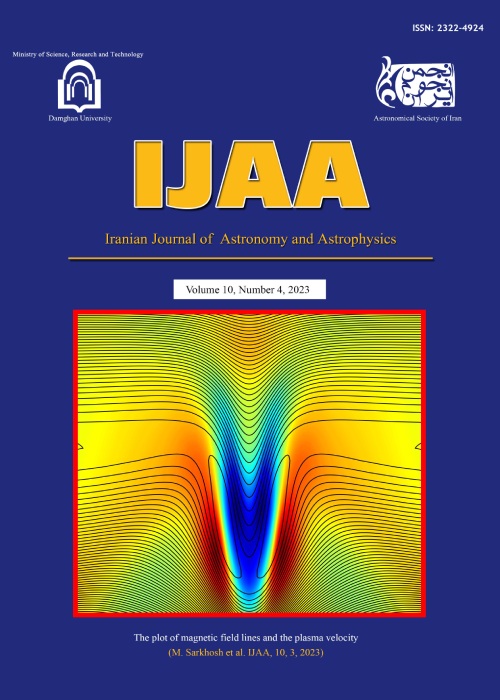Stellar Populations in the Central Galaxies of Fossil Groups
Author(s):
Abstract:
It is inferred from the symmetrical and luminous X-ray emission of fossil groups that they are mature, relaxed galaxy systems. Cosmological simulations and observations focusing on their dark halo and inter-galactic medium properties confirm their early formation. Recent photometric observations suggest that, unlike the majority of non-fossil brightest group galaxies (BGGs), the central early-type galaxies in fossil groups do not have boxy isophotes, and are therefore likely to have formed in non-equal-mass, gas-rich galaxy-galaxy mergers.
Although the isophotal shapes of early-types can be used to infer the nature of the parent galaxies of their most recent mergers, detailed star-formation histories of the galaxies are also needed, in order to uncover the epoch of these mergers and the differences in the physical processes which produce fossil groups rather than `normal' galaxy groups. In this study, we use a powerful long-baseline (UV-optical), multi-component, stellar population fitting technique to disentangle the star-formation history of the dominant central giant elliptical galaxy in a sample of five fossil groups, and compare this with a control sample of non-fossil BGGs, in an attempt to fully understand their merger histories. Our technique allows us to identify multiple epochs of star formation in a single galaxy, and constrain the metallicities of the constituent stellar populations.
Resolving the populations in this way gives us a much clearer picture of galaxie's histories than simply using the mean age / metallicity of total stellar populations recovered by more conventional techniques using absorption line strengths.
We find that i) the dominant stellar components in both galaxy samples are old (>10 Gyr), metal-rich (≥solar) and statistically indistinguishable in terms of their ages, metallicities and relative mass fractions; ii) the ages of the secondary, younger stellar components are also statistically indistinguishable between the two samples; iii) the central fossil galaxies have secondary stellar components which have significantly lower metallicities than the corresponding stellar populations in the BGG sample.
In a gas-rich merger, dissipation dilutes the previously-enriched gas in the central regions of the parent galaxies with gas which has not been metal-enriched, lowering the metallicity of the stars produced. Hence, we conclude that the central fossil galaxies are the products of early and exceptionally gas-rich mergers, which leaves them with lower metallicities in their most recent merger-induced stellar populations than their BGG counterparts. In contrast, although the last starburst-inducing merger of the 'normal' BGGs occurred at the same epoch as that of the fossil BGGs, they have undergone a subsequent dissipation-less merger, leaving them in the present day with boxy isophotes and more disturbed x-ray emission, but no further significant star formation.
Although the isophotal shapes of early-types can be used to infer the nature of the parent galaxies of their most recent mergers, detailed star-formation histories of the galaxies are also needed, in order to uncover the epoch of these mergers and the differences in the physical processes which produce fossil groups rather than `normal' galaxy groups. In this study, we use a powerful long-baseline (UV-optical), multi-component, stellar population fitting technique to disentangle the star-formation history of the dominant central giant elliptical galaxy in a sample of five fossil groups, and compare this with a control sample of non-fossil BGGs, in an attempt to fully understand their merger histories. Our technique allows us to identify multiple epochs of star formation in a single galaxy, and constrain the metallicities of the constituent stellar populations.
Resolving the populations in this way gives us a much clearer picture of galaxie's histories than simply using the mean age / metallicity of total stellar populations recovered by more conventional techniques using absorption line strengths.
We find that i) the dominant stellar components in both galaxy samples are old (>10 Gyr), metal-rich (≥solar) and statistically indistinguishable in terms of their ages, metallicities and relative mass fractions; ii) the ages of the secondary, younger stellar components are also statistically indistinguishable between the two samples; iii) the central fossil galaxies have secondary stellar components which have significantly lower metallicities than the corresponding stellar populations in the BGG sample.
In a gas-rich merger, dissipation dilutes the previously-enriched gas in the central regions of the parent galaxies with gas which has not been metal-enriched, lowering the metallicity of the stars produced. Hence, we conclude that the central fossil galaxies are the products of early and exceptionally gas-rich mergers, which leaves them with lower metallicities in their most recent merger-induced stellar populations than their BGG counterparts. In contrast, although the last starburst-inducing merger of the 'normal' BGGs occurred at the same epoch as that of the fossil BGGs, they have undergone a subsequent dissipation-less merger, leaving them in the present day with boxy isophotes and more disturbed x-ray emission, but no further significant star formation.
Keywords:
Language:
English
Published:
Iranian Journal of Astronomy and Astrophysic, Volume:1 Issue: 1, Spring 2014
Pages:
65 to 76
magiran.com/p1653824
دانلود و مطالعه متن این مقاله با یکی از روشهای زیر امکان پذیر است:
اشتراک شخصی
با عضویت و پرداخت آنلاین حق اشتراک یکساله به مبلغ 1,390,000ريال میتوانید 70 عنوان مطلب دانلود کنید!
اشتراک سازمانی
به کتابخانه دانشگاه یا محل کار خود پیشنهاد کنید تا اشتراک سازمانی این پایگاه را برای دسترسی نامحدود همه کاربران به متن مطالب تهیه نمایند!
توجه!
- حق عضویت دریافتی صرف حمایت از نشریات عضو و نگهداری، تکمیل و توسعه مگیران میشود.
- پرداخت حق اشتراک و دانلود مقالات اجازه بازنشر آن در سایر رسانههای چاپی و دیجیتال را به کاربر نمیدهد.
In order to view content subscription is required
Personal subscription
Subscribe magiran.com for 70 € euros via PayPal and download 70 articles during a year.
Organization subscription
Please contact us to subscribe your university or library for unlimited access!


